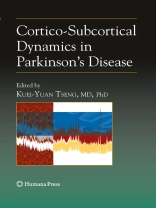The striatum is the principal input structure of the basal ganglia. Numerically, the great majority of neurons in the striatum are spiny projection neurons, which produce the inhibitory output of the striatum to the globus pallidum and substantia nigra. The major glutamatergic afferents to the striatum from the cerebral cortex make monosynaptic contact with spiny projection neurons. The dopaminergic afferents from the substantia nigra also synapse directly on the spiny projection neurons. Thus, the spiny projection neurons play a crucial role in the input–output operations of the striatum by integrating glutamatergic cortical inputs with dopaminergic inputs and producing the output to other basal ganglia nuclei. Anatomical observations made nearly 30 years ago suggested that inhibitory interactions among the spiny projection neurons of the striatum are very pr- able. Individual spiny projection neurons produce a local axonal plexus in the spheroidal space occupied by their own dendritic trees [1, 2]. Based on the GABAergic nature of these neurons and their synaptic contacts with other spiny neurons, several authors have proposed that the spiny projection neurons form a lateral inhibition type of neural network [3–5]. In the idealised concept of lateral inhibition, each output neuron makes inhibitory synaptic contact with its neighbours [5]. However, there are physical limitations set by the extent of axonal and dendritic trees, and the number of synaptic sites, which mean that lateral inhibition is limited to a local domain of inhibition.
Table of Content
Cortico-Subcortical Circuits and Parkinson’s Disease.- Leading Toward a Unified Cortico-basal Ganglia Functional Model.- Modeling Parkinson’s Disease: 50 Years Later.- Physiological Studies of the Cortico-subcortical Dynamics and Parkinson’s Disease.- Phasic Dopaminergic Signaling: Implications for Parkinson’s Disease.- Striatal Dendritic Adaptations in Parkinson’s Disease Models.- Diversity of Up-State Voltage Transitions During Different Network States.- The Corticostriatal Pathway in Parkinson’s Disease.- Cholinergic Interneuron and Parkinsonism.- Basal Ganglia Network Synchronization in Animal Models of Parkinson’s Disease.- Converging into a Unified Model of Parkinson’s Disease Pathophysiology.- The Corticostriatal Transmission in Parkinsonian Animals: In Vivo Studies.- Striatal Nitric Oxide–c GMP Signaling in an Animal Model of Parkinson’s Disease.- Dopamine–Endocannabinoid Interactions in Parkinson’s Disease.- Glutamate Plasticity in an Animal Model of Parkinson’s Disease.- Computational Analyses of the Cortico-Subcortical Dynamics and Parkinson’s Disease.- Neuromodulation and Neurodynamics of Striatal Inhibitory Networks: Implications for Parkinson’s Disease.- Dopaminergic Modulation of Corticostriatal Interactions and Implications for Parkinson’s Disease.- Neurobiology and Pathophysiology of Parkinson’s Disease.- Pathogenesis of Oxidative Stress and the Destructive Cycle in the Substantia Nigra in Parkinson’s Disease.- Regulation of G-Protein-Coupled Receptor (GPCR) Trafficking in the Striatum in Parkinson’s Disease.- Atypical Parkinsonism in the French West Indies: The Plant Toxin Annonacin as a Potential Etiological Factor.- Cognitive Deficits in Parkinson’s Disease.- Pharmacological and Non-Pharmacological Treatments in Parkinson’s Disease.- Dopamine Replacement Therapy in Parkinson’s Disease: Past, Present and Future.- Molecular, Cellular and Electrophysiological Changes Triggered by High-Frequency Stimulation of the Subthalamic Nucleus in Animal Models of Parkinson’s Disease.- Surgical Strategies for Parkinson’s Disease Based on Animal Model Data: GPi and STN Inactivation on Various Aspects of Behavior (Motor, Cognitive and Motivational Processes).- Antidromic Cortical Activity as the Source of Therapeutic Actions of Deep Brain Stimulation.- Cell-Based Replacement Therapies for Parkinson’s Disease.
Language English ● Format PDF ● Pages 316 ● ISBN 9781603272520 ● File size 8.3 MB ● Editor Kuei-Yuan Tseng ● Publisher Humana Press ● City NJ ● Country US ● Published 2009 ● Downloadable 24 months ● Currency EUR ● ID 2151000 ● Copy protection Social DRM












